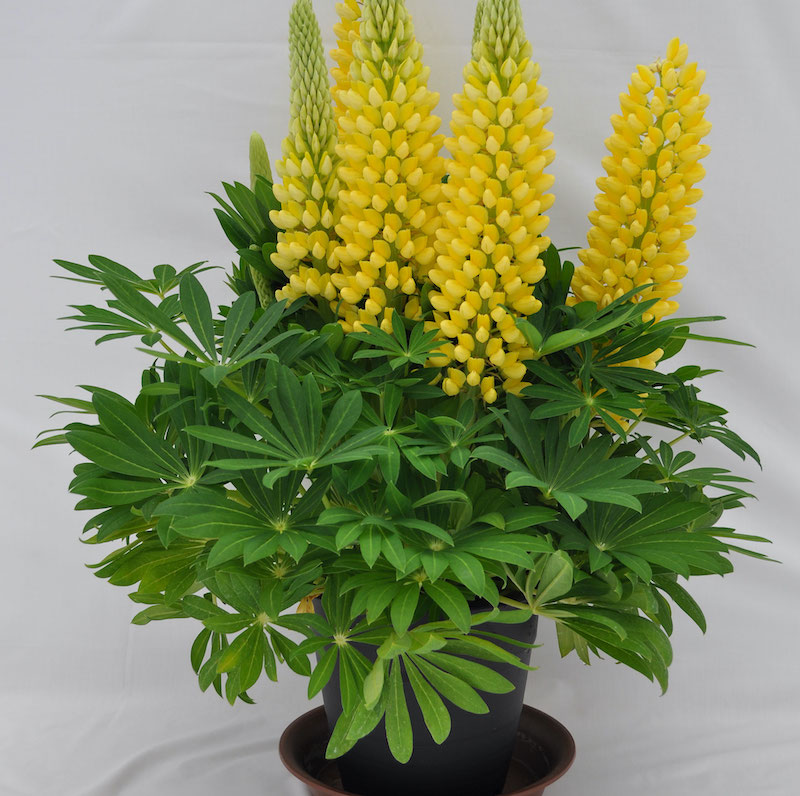Ornamental perennials will happily grow in pots if you have a small garden or want to create a seasonal display on a deck or patio of containers. The smaller cultivars, such as the Mini Gallery™ series, work well as filler plants for mixed plantings. Lupines have tall flower spikes that add vertical interest to container groupings and distinctive foliage, which contrasts nicely with other plants. The flowering period of Lupines can be extended with regular deadheading of spent flower spikes.

Planting Lupine in Pots
The best time of year to pot up Lupines is in the early spring while the plant comes out of dormancy. Local nurseries will have Lupines in stock early in the spring. The container-grown plants are cold hardy and can withstand a light, unseasonably late frost. Choose a location with full sun or partial shade to promote the best blooming. Too much shade will result in smaller flowers and weak foliage, which is susceptible to aphid damage.
Containers need to be deep so that the taproots have enough room to develop fully. Pots should be at least 12 inches in diameter to grow single plants. Mixed plantings will need much larger containers. The drainage of the pot needs to be excellent. Depending on where you garden, the pot material needs to be able to endure the winter without cracking, flaking, or breaking. Composite resin and plastic pots are the most durable for cold climates in zones 4-6.
Best Soil For Lupine in Pots
An all-purpose potting soil is perfect for containers of Lupines. The mix needs to be lightweight and free draining, so that the roots do not spend time sitting in waterlogged soil. Contrary to previous advice, adding a layer of rocks to the bottom of containers does not improve drainage. The rock layer creates a barrier for water to drain through the soil.
If you are worried about soil washing out of the drainage holes, a piece of landscape fabric works to cover the hole from the inside. Adding mulch to the top of the pot will have the same benefits as using it in the garden: moisture retention, cooling of the root system, and weed deterrent. Mulches for pots can be anything from organic compost to decorative river pebbles.
Caring For Lupine in Planters
Lupines are fairly carefree when growing in the garden. Growing Lupine in containers involves more care and attention, but they are still low maintenance. Read on for some great tips about watering, fertilizing, and protecting your potted lupine.

Watering Lupine in Pots
Lupine thrives with regular moisture and in hot climates, will need to be watered more often. Water when the top 1-2 inches of potting soil are dry to the touch. This allows the soil to dry out slightly between waterings. Water the pots as early in the day as possible. Soil that is cooler and possibly still damp from a heavy morning dew is easier to saturate thoroughly.
Water the pot long enough that water flows out of the drainage holes. This lets you know that all of the soil is saturated. If you garden in a climate with heavy spring or summer rains, hold back on watering if there has been more than 1 inch of precipitation a week.
Fertilizing Lupine in Pots
Fertilizing needs to be more regular for pot-grown Lupines. They can fix nitrogen from the air, reducing the amount of supplemental nitrogen needed. The best fertilizer is a liquid Tomato or Rose feed with a higher content of phosphorus and potassium than nitrogen. Look for formulations with an NPK ratio of 2-6-4 or 0-4-2. Supplementing one watering every two weeks with a feeding diluted in water will keep Lupines growing tall and strong.
Winter Care For Lupine in Pots
Lupines are cold hardy and survive winters in some of the coldest growing zones. Growing the plants in pots makes it easy to move them to a sheltered location from prevailing winter winds and storms. If the containers are too large to carry, the pot can be wrapped in burlap or horticultural fleece layers to insulate the root system.
Roots are much more insulated in the ground than in a pot and should be treated as if they are growing in a colder climate zone. Drainage should be monitored over the winter months. Pots standing in water or getting too much rainfall under a gutter downspout or roof eave must be moved to a drier spot. Placing bricks or pot feet under the container will also help keep the container out of standing water.
Growing Lupine Indoors
Lupines don't make good houseplants and don't need the added protection of a heated garage or greenhouse. The plant needs a period of dormancy to regrow in the spring. Seeds of Lupine can be started in late summer and then grown in an unheated greenhouse for the winter. The new plants should be planted after the risk of frost passes.
 |
Author Robbin Small - Published 8-24-2022 |
